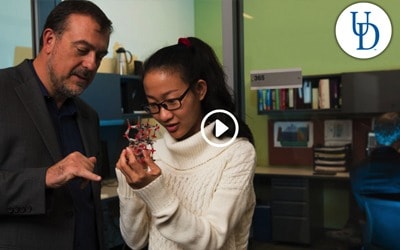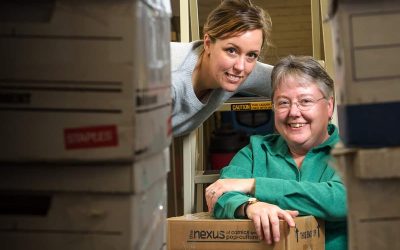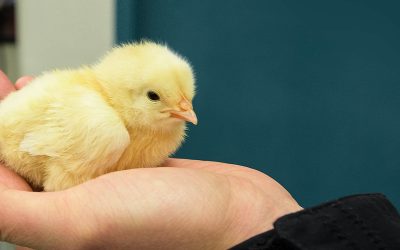

ABOUT THE AUTHOR
Mark Bowden, Distinguished Writer in Residence at the University of Delaware, is a bestselling author and journalist. He was a reporter and columnist for The Philadelphia Inquirer for more than 30 years before officially joining the UD faculty in 2013.
His book Black Hawk Down, about the 1993 battle of Mogadishu, Somalia, was a finalist for the National Book Award and the basis of the Academy Award-winning film. Other bestsellers include The Best Game Ever, the story of the 1958 NFL championship game; Worm, about the Conficker computer virus; and The Finish, an account of the mission to kill Osama bin Laden.
Bowden is working on a new book on the Vietnam War. He also is a contributing editor to Vanity Fair and a national correspondent for The Atlantic.
What science writing can teach us
I had a subscription to Scientific American … which I never read, or, rather, couldn’t read, because in 1980 the articles were far too technical. I was working as a newspaper reporter and had subscribed to it in a hopeful effort to fill a gaping hole in my education since I had scrupulously avoided science and math classes after high school. But I realized how rapidly discovery and technology were changing the world, and felt I ought to try to better understand it. The subscription had been a failure.
But I had put it down on my application to The Philadelphia Inquirer, and that was enough for the paper to ask me if I’d like to become its new science writer. At the time, newspapers were looking for science reporters with a background in such things, so I kept my ignorance quiet. What I discovered was that ignorance was the best qualification for writing about science in a newspaper. In my first year, I won the AAAS Science Writing Award for a story about breeding innovations in the milk industry. You have to be ignorant to ask the appropriately ignorant questions.
“So, exactly what is an electron?” I would ask.
“Could you explain to me the difference between hardware and software?”
“What is this thing called the Internet?”
I try to pass this lesson along to my students. Don’t be afraid to ask a stupid question, I tell them. If you don’t understand it, your readers won’t either. Besides, an early reporting lesson is that experts are not offended by such basic questions. Most people love to explain themselves and their work.
UD is a perfect laboratory for would-be science writers. Work goes on in just about every field of scientific inquiry, and most of the experts on campus are also teachers, so they are used to curious students. I tell my students to take an interest not just in the science, but in the scientists. I urge them to spend time in the lab or in the field with the subjects of their stories.
Science is both abstract and very real. To connect readers with the ideas that motivate researchers, it helps to learn and write about them and the actual work they do. In a story, say, about the effects of warming trends in the Chesapeake Bay, it’s worth taking a trip to Lewes and getting up early in the morning to follow researchers out into muddy swamps.
People are a good way into any complex story, but so is process. I tell my students to observe experiments and learn what is going on, step by step. If you are describing an effort to create artificial human tissue, as junior Season Cooper did, it helps to break down the steps in that process, beginning with the preparation of a “hydrogel,” a water-based gelatin that is neither too stiff nor too runny, and then painstakingly building inside it a network of synthetic blood vessels.
If you are trying to describe efforts to build a chicken better equipped to deal with the effects of global warming, as senior Jonathan Hadad did, the process begins by culturing chicken cells in petri dishes, warming them and then performing genetic analysis on the effects deep inside the cells, looking for the right kinds of proteins that help keep them alive. Breaking things down step-by-step in the lab leads even a science-deprived reader like me toward a deeper understanding of the work. It’s also invariably fascinating!
The basics of good science writing are in most ways no different than the basics for any kind of storytelling. You need characters, setting, action, dialogue … in short, you need SCENES. Something has to happen in a piece of writing to bring it to life.
I hammer away at my students to find scenes for their story, moments in the lab or in the field that enliven their prose. They can get such material by observation (and good note-taking) or by interview, by getting the subjects of their story talking in detail about their work. What was the biggest failure in the lab? How did your subjects respond? Did anything happen in the field that made you laugh? Do you remember a moment when the work surprised you, or taught you something truly new?
Once they unearth moments that could become scenes in their stories, they need to dig. They need to know when the scene happened, and where. Who was present? Was it raining or sunny? What exactly was said? What were you wearing? And so on. These kinds of questions are counterintuitive. People look at you funny when you ask them. But as any writer will tell you, details like these are necessary to flesh out scenes in a story. Novelists can make them up. When you write nonfiction, you have to go out and aggressively find them.
I am certain that by the end of each semester I sound like a broken record to my writing students. I stress these basics, all of which are easier to say than to do.
My science writing students are often at a particular disadvantage, in that many of them come to my class from science-related disciplines, with no experience reporting and writing. It is gratifying to see them becoming better reporters and writers with each story. Few will go on to become professional writers—this past fall semester, I had several students preparing for careers as doctors or veterinarians—but I believe their ability to ask probing questions and to explain technical details clearly and colorfully will profit them enormously. Clear writing is, after all, clear thinking. We could all use more of that.


Peter Murphy, a lanky, charismatic master’s student at Drexel University, entered the room to begin. He was conducting a clinical trial of a method to minimize invasive surgery and expensive procedures on children with hydrocephalus.
Lauren, at just 6 years old, has been diagnosed with this disease, which is rare. Only about one in 500 children are afflicted annually. Those with the condition accumulate excess fluid in the brain. Without treatment, it can cause brain damage and eventually death.
Shortly after Lauren was diagnosed, a neurosurgeon at the hospital, Dr. Joseph H. Piatt Jr., placed a ventriculoperitoneal (VP) shunt, a small plastic device, inside her skull behind her left ear that drained the excess cerebrospinal fluid (CSF) from the ventricles of her brain into her belly. This is a very common procedure for individuals with hydrocephalus that leaves only a small, U-shaped scar behind the ear and a bald patch for a brief period of time. But, as with almost all medical procedures, there are included risks. One of those risks includes malfunction and blockage of the VP shunt by mechanical error.
A VP shunt is composed of two tubes, called catheters, and a valve, or “fluid pump.” When the shunt malfunctions, the excess fluid doesn’t drain. It accumulates in the ventricles of the brain. If this occurs, the child begins to demonstrate behavioral changes such as sleepiness, irritability, seizures and vomiting.

Amanda Vaile, from Hockessin, Delaware, graduated from UD this past spring with a degree in pre-veterinary medicine and animal biosciences. She begins veterinary school at Oklahoma State University this fall.
Before this clinical trial, the standard procedure for determining if a shunt was blocked was to do an MRI or perform another surgery. MRIs are expensive, and surgery always poses dangers to the child.
Lauren is one of 12 children between the ages of 2 and 17 who are participating in the trial. Each has demonstrated behavioral issues that may signal a blockage.
“When a child is experiencing behavioral changes that indicate a possible blockage, we work on ruling it out in the least invasive way possible,” Murphy said.
The way the VP shunt is placed, a portion of it runs directly over the child’s clavicle, or collarbone. It is easy to tell where that is because you can actually feel it by running your finger over the skin. In this trial, a square white sensor with wires connected to a computer is placed directly on top of this spot.
“Lauren is one of my most memorable patients because when I tried to use the marker to indicate where the shunt overlapped the clavicle, she thought I was coming at her with a needle and just about jumped across the room,” Murphy said. “Now I always tell the kids ahead of time that I’m not poking them with any needles.”
Once the sensor is turned on, Murphy uses ice packs to cool a different section of skin that still overlays the shunt, but is slightly above the spot being tested.
“Through conductive (direct contact) heat loss, the coldness of the skin cools down the warm CSF in the VP shunt just beneath it,” he said. “Then, if the sensor detects a drop in temperature, we conclude that the CSF is flowing, the shunt is not blocked, and the behavioral issues are most likely due to a more minor cause.”
This procedure is so simple it can be done at home. This minimizes hospital visits, which are stressful and expensive.
To prove the effectiveness of the technique, Murphy needs to track patients long enough to see what actually caused their malfunction-like symptoms.
The clinical trial is still in the beginning stages and needs to test several hundred more patients before it can act as a stand-alone diagnostic test. Most patients still have an MRI done to get a better look what is causing their symptoms.
“[The doctors] are looking for an enlarged ventricle or even a shift in the midline caused by a buildup of CSF,” Murphy explained. “If there is clinical evidence to support a blockage of the shunt, then the child is scheduled almost immediately for shunt revision surgery. Only one or two out of the 12 patients enrolled has gone on to have surgical intervention.”
As for little Lauren, she thankfully did not have a shunt blockage. Her clinical trial test went well and her MRI results showed no issues. After undergoing more routine tests, it turned out she had a viral bug that caused her to exhibit malfunction-like symptoms. She was sent home with antiviral medication and the doctors asked her to come back if any new symptoms arise.
“The hope is that this trial could be used as a stand-alone diagnostic test or in conjunction with traditional diagnostics, such as an MRI or surgery, but only time will tell,” Murphy said.

Monideepa Chatterjee, a senior biomedical engineering student in the Honors Program at UD, is trying to do just that, specifically one that imitates “intravasation,” the critical stage at which a cancer cell leaves its original source and enters the bloodstream.
One day after a lecture class, Chatterjee was approached by Professor John Slater and asked if she would like to be one of his undergrad researchers. He mentioned cancer research. Eventually, Chatterjee produced her own project entitled “A Three-Dimensional, in vitro Tissue Culture Model for High-Throughput Screening of Metastatic Potential.”
“I was pretty excited—for me this meant that my professor noticed how well I was doing in the large lecture class, and I was also excited by the research he’s doing,” Chatterjee said. “He also went to one of the universities I’d like to attend for my Ph.D., so it offered me an opportunity to learn more about the school.”
In plain terms, she is studying how cancer cells make the leap from a single tumor to a spreading and multiplying threat throughout the body.
According to a 2015 report by the American Cancer Society, over half a million people are expected to die of the disease this year, amounting to a daily figure of 1,620 people per day. If diagnosed in an early stage, cancer-stricken individuals would have a greater chance of survival.
Although early detection would curb the number of deaths, diagnosis can take weeks or even months. For some, the delay negates the purpose of testing.
Chatterjee began her research this summer at Delaware Technology Park through the University’s biochemistry lab. She set out to create the “chip.” Her work employs what is called “lab-on-a-chip” technology, which involves crafting a contained, synthetic substitute for human tissue.
First, she takes human cancer cells and encourages their growth in the laboratory. After the cells grow and multiply successfully, she makes hydrogel, a clear substance that possesses a similar consistency to gelatin. Her goal is to create a balanced consistency for it, neither too stiff nor too loose, enough like human tissue that cancer cells behave in it the same way they do in the body.

English major Season Cooper (right) interviewed Monideepa Chatterjee about her cancer research. Chatterjee, an Honors Program student in biomedical engineering, graduated this past spring. Both are from Wilmington, Delaware.
Next, she must create a vascular network in the hydrogel that mirrors the natural blood system. The process is proprietary, so Chatterjee cannot explain it in detail, but she said that it is “very time consuming.”
Following the vascular modeling, Chatterjee lines the network with endothelial cells, which in the body form a protective layer inside organs, impeding the movement of cancer cells. The idea is to model the obstacles a cancer cell encounters naturally.
Once the development portion is completed, the cancer cells are introduced to the “chip,” and the results are analyzed through gene sequencing. The results would help cancer patients get diagnosed in as fast as two or three days.
While Chatterjee’s research will take up to five years to complete and even more to become FDA regulated, the targeted method of diagnosis is certain to have positive implications.
Although the work is complicated, Chatterjee said she is excited about its potential, especially, she said, “in countries where they don’t have access to medical facilities and such techniques are being used to diagnose diseases like AIDS or malaria.”

Surprisingly, the fashion industry and the environment are actually very interconnected. Last summer, UD junior Jillian Silverman looked for potential solutions to the emerging waste problems within the fashion industry.
Silverman, with her shoulder-length blonde hair sprouting everywhere, spoke about both the environment and fashion with enthusiasm and passion.
“You know, I was always really into fashion and the design of clothes even at a young age,” she said. “But this past year, I started realizing how harmful the industry was to our surrounding environment, and I wanted to see if I could do anything to help.”
Silverman set out to create a textile that would be 100 percent compostable. Being compostable means that a product would leave little to no waste behind after it is disposed. It would completely disintegrate into natural elements in the environment, like it never even existed.
To create this textile, she would be using a specific root structure in mushrooms called mycelium. Mycelium has been used many times to create compostable packaging, but has never been used to create wearable fabric. It is an interlocking root structure, with a vibrant white color and soft texture. At first glance, the root structure looks very similar to a newly formed spider web. Each root shoots off from the center, growing over top each other in a rather unorganized way.

Connor Milligan, a senior majoring in environmental studies from Cherry Hill, New Jersey, interviewed Jillian Silverman, who is continuing on at UD for her master’s degree in fashion and apparel studies. She’s from New Freedom, Pennsylvania.
Silverman visited Kaolin Mushroom Farm in Kennett Square, Pennsylvania, picked up the mycelium and began her research. For the next 10 weeks, she operated out of a lab room on the third floor of Alison Hall. The lab is not sophisticated. It resembles a normal classroom. At the center were two long black lab tables where she conducted most of the experiments. At the beginning of the summer, Silverman set out with hopes of creating the compostable fabric within 10 weeks. But early on, she knew this wasn’t realistic.
“There was just no way I would have enough time to accomplish that,” said Silverman, “so I had to kind of reset my end goal midway through the summer.”
The new goal she set was figuring out the best way to grow the mycelium. Each week, she placed the material on square sheets of soft fabric laid out on the lab tables. Then Silverman introduced a different substrate on each plate to trigger the growth of the mycelium. A substrate is a material that encourages growth and nourishment of an organism. She checked the progress of each plate every day.
“Overall, it was kind of just a lot of waiting and watching,” said Silverman. “It certainly required a lot of patience.”
One of the first substrates used in the lab was natural grass. This turned out to be very successful, leading to tremendous mycelium growth in only a matter of days. However, unbeknownst to Silverman, a vile mold gradually developed all over the plate, forcing her to throw out all the mycelium that had grown.
“The mold was green and funky-looking,” said Silverman. “It was very thick and furry, and quite honestly, absolutely disgusting.”
Experiment conditions were far from ideal for Silverman for the next week to two weeks because there was a lingering stench from the disposed mold.
“It’s tough because there really isn’t a blueprint on how to do something like this,” said Silverman. “It’s something that’s never been done before, so we had to sort of wing it when we were conducting the experiments.”
Although there were mishaps, and no set experimentation process, Silverman made adjustments on the go and achieved at least part of her original goal. Of all the substrates tested, she found that natural grass and psyllium were the most successful. Psyllium is a leafy-stemmed plantain that is extremely similar to wheat in appearance.
Now that she knows how to effectively grow mycelium, the next step is making it into something that can actually be worn. As it stands now, Silverman is working with a few professors in the fashion department to gather grant money so that she can further her research.
The road to making mycelium-based clothes is certainly a long one, but Silverman appears to be headed in the right direction.
MORE STORIES
Energy IQ
Put your Energy IQ to the test, and let’s see if you are an energy guru or a fossil fool.
Catalysis Center for Energy Innovation
Cool video highlights CCEI’s mission of turning cornstalks and wood chips into fuels, electricity and chemicals.
Scanlon papers now part of disaster resource collection
T. Joseph Scanlon, a respected journalism professor in Canada, had a long-time relationship with the University of Delaware’s Disaster Research Center, which is now the repository of his over 70,000-piece collection.
Honors
The UD community celebrates its first Gates Cambridge Scholar, two new fellows in the National Academy of Inventors, and the first woman to receive the Soil Science Society of America’s Kirkham Soil Physics Award.
News briefs
A humanoid robot joins the pediatric rehab team, a new UD study suggests online shopping may not be as “green” as we thought, a professor aims to improve student experiences in global health, and summer research all-stars take the field.
Keeping a killer flu in check
Who do you call when bird flu comes knocking? UD’s Avian Biosciences Center is working to contain the threat of bird flu—locally and globally.
Research Magazine Survey
We value your opinion. To show you how much, we will award a $100 Barnes & Noble gift card to three people who complete our survey. To be entered in this random drawing, please complete the survey by Nov. 1, 2016.
UD Authors
In her award-winning book, historian Christine Heyrman explores how the first U.S. missionaries in the Middle East influenced a nation’s attitudes toward Islam.
New Train Station Project on Track for STAR Campus
An upgraded transportation hub in Newark will bring new riders and serve as an anchor for UD’s 272-acre Science, Technology and Advanced Research (STAR) Campus.
A trusted partner when the world turns upside down
Decisions made in times of disaster can be the difference between life and death, restoration and ruin. UD’s Disaster Research Center offers field-tested methods to strengthen recovery efforts.
Ch-Ch-Ch-Changes…
With significant change all around us, Delaware’s leaders—including the University of Delaware—are working to turn adversity into new opportunity.
Fueling the quest for green energy
Turning cornstalks and wood chips into renewable energy and valuable chemicals isn’t easy, but it is a promising focus of research at the Catalysis Center for Energy Innovation.














